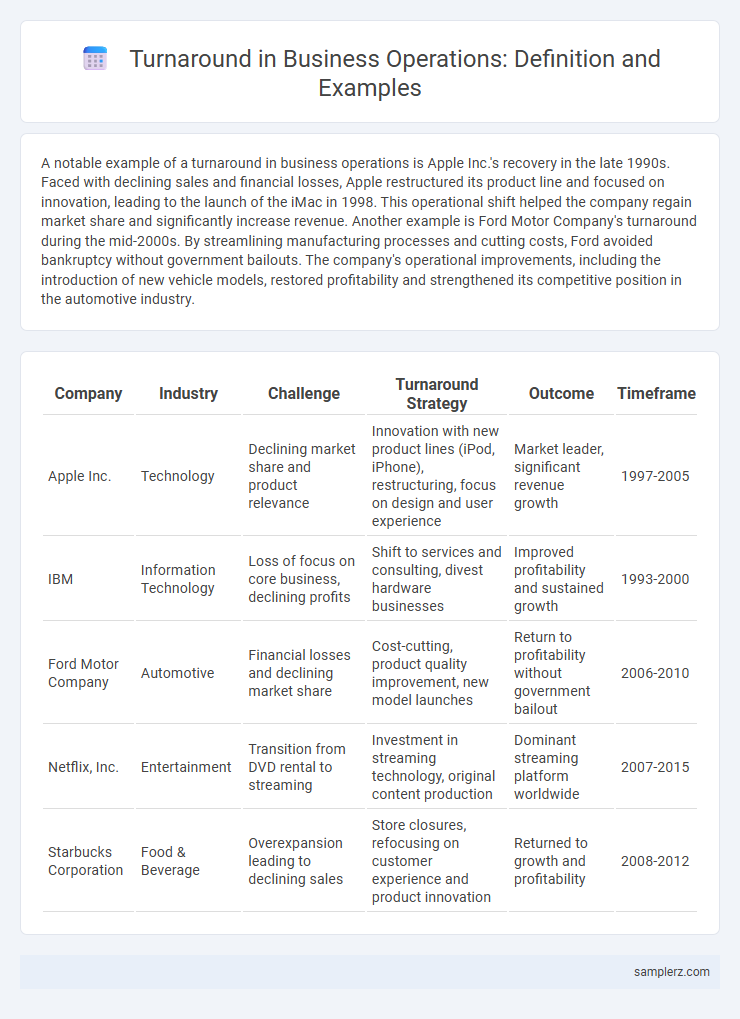A notable example of a turnaround in business operations is Apple Inc.'s recovery in the late 1990s. Faced with declining sales and financial losses, Apple restructured its product line and focused on innovation, leading to the launch of the iMac in 1998. This operational shift helped the company regain market share and significantly increase revenue. Another example is Ford Motor Company's turnaround during the mid-2000s. By streamlining manufacturing processes and cutting costs, Ford avoided bankruptcy without government bailouts. The company's operational improvements, including the introduction of new vehicle models, restored profitability and strengthened its competitive position in the automotive industry.
Table of Comparison
| Company | Industry | Challenge | Turnaround Strategy | Outcome | Timeframe |
|---|---|---|---|---|---|
| Apple Inc. | Technology | Declining market share and product relevance | Innovation with new product lines (iPod, iPhone), restructuring, focus on design and user experience | Market leader, significant revenue growth | 1997-2005 |
| IBM | Information Technology | Loss of focus on core business, declining profits | Shift to services and consulting, divest hardware businesses | Improved profitability and sustained growth | 1993-2000 |
| Ford Motor Company | Automotive | Financial losses and declining market share | Cost-cutting, product quality improvement, new model launches | Return to profitability without government bailout | 2006-2010 |
| Netflix, Inc. | Entertainment | Transition from DVD rental to streaming | Investment in streaming technology, original content production | Dominant streaming platform worldwide | 2007-2015 |
| Starbucks Corporation | Food & Beverage | Overexpansion leading to declining sales | Store closures, refocusing on customer experience and product innovation | Returned to growth and profitability | 2008-2012 |
Introduction to Operational Turnaround
Operational turnaround involves restructuring business processes, improving supply chain efficiency, and optimizing resource allocation to restore profitability. Companies like Ford in the 2000s implemented rigorous cost-cutting measures and enhanced production workflows, resulting in significant financial recovery. Key strategies include revising operational models, investing in technology upgrades, and realigning workforce capabilities to boost overall performance.
Key Drivers of Successful Turnarounds
Identifying key drivers such as leadership commitment, financial restructuring, and operational efficiency enabled a struggling manufacturing firm to reverse declining revenues and restore profitability within 12 months. Focusing on customer-centric product innovation and streamlining supply chain processes resulted in a 25% reduction in costs and a 30% increase in market share. These strategic initiatives underscore the importance of data-driven decision-making and agile execution in successful operational turnarounds.
Classic Case Study: Manufacturing Sector Revival
A classic example of a manufacturing sector turnaround is General Motors' recovery in the late 2000s. After declaring bankruptcy in 2009, GM restructured its operations by streamlining production lines, investing in innovation, and focusing on fuel-efficient vehicles. This strategic shift led to a return to profitability and strengthened market position within a highly competitive automotive industry.
Digital Transformation as a Turnaround Catalyst
Digital transformation acts as a powerful catalyst for business turnarounds by integrating advanced technologies such as artificial intelligence, cloud computing, and data analytics to streamline operations and enhance customer experiences. Companies like Microsoft successfully leveraged digital transformation to shift from traditional software sales to cloud-based subscription models, resulting in substantial revenue growth and market relevance. Embracing digital tools enables organizations to optimize workflows, improve decision-making processes, and achieve scalable growth during operational turnarounds.
Turnaround in Supply Chain Management
A notable turnaround in supply chain management was achieved by Apple during the 2020 global crisis, where strategic diversification of suppliers and implementation of advanced inventory analytics reduced lead times by 30%. Toyota's adoption of just-in-time (JIT) inventory and digital tracking systems minimized waste and improved delivery accuracy by 25%. Investing in blockchain technology for real-time supply chain visibility enabled Walmart to enhance traceability and cut product recall times from days to hours.
Leadership Changes Driving Operational Success
Leadership changes at Nokia, with new CEO Rajeev Suri, spearheaded a strategic shift focusing on core telecommunications technology, resulting in a significant turnaround. The company streamlined operations, divested non-core assets, and invested heavily in 5G infrastructure, boosting market share and profitability. This leadership-driven transformation restored investor confidence and positioned Nokia as a competitive player in the telecom sector.
Financial Restructuring for Business Revival
A notable example of turnaround through financial restructuring is General Motors' 2009 bailout, where strategic debt reduction and capital injection enabled swift revival and enhanced operational efficiency. By renegotiating creditor terms and shedding non-core assets, the company restored liquidity and stabilized cash flow. This financial restructuring facilitated improved market competitiveness and long-term sustainability.
Employee Engagement During Turnarounds
High employee engagement during operational turnarounds drives productivity and accelerates recovery by fostering collaboration and innovation. Companies like Ford effectively revitalized their workforce through transparent communication and skill development programs, leading to improved morale and performance. Enhanced engagement reduces resistance to change, allowing businesses to swiftly implement strategic shifts and achieve sustainable growth.
Technology Integration and Process Optimization
A successful business turnaround often involves integrating advanced technologies such as AI-powered analytics and cloud-based automation platforms to streamline operations and reduce costs. Process optimization through Lean Six Sigma methodologies enhances efficiency by eliminating bottlenecks and improving workflow consistency. Companies leveraging these strategies report up to a 40% increase in productivity and significant improvements in customer satisfaction metrics.
Lessons Learned from Turnaround Success Stories
Effective turnaround strategies in business often involve decisive leadership, thorough operational analysis, and rapid implementation of cost-cutting measures. For instance, companies like Apple in the late 1990s revamped product lines and streamlined operations under Steve Jobs' leadership, demonstrating the impact of visionary direction combined with strategic focus. Lessons learned emphasize the value of clear communication, employee engagement, and adaptability in overcoming operational challenges and restoring profitability.

example of turnaround in operation Infographic
 samplerz.com
samplerz.com